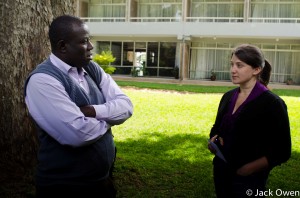Carbon for Water? Now how does that work?
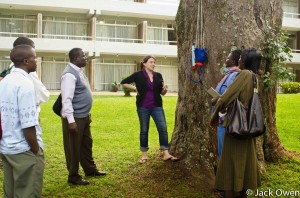 Vestergaard Frandsen are a Swiss company involved in the research, development, manufacture and distribution of humanitarian products. They are the guys behind the Permanet mosquito net. On their website they talk of ‘profit for a purpose’. Right now, in Western Province, Kenya they are rolling out a water filtration program intended to cover 90% of homes in just 25 days. That is 900,000 households overall, or 35,000 new filters moving out every single day! The company are investing 30m USD over ten years. Why? Because the carbon saved through filtering water rather than boiling it will be transferred into carbon credits and sold on the European market for a profit. To say this is highly ambitious is an understatement, so I hopped on a flight from Mombasa and took a closer look.
Vestergaard Frandsen are a Swiss company involved in the research, development, manufacture and distribution of humanitarian products. They are the guys behind the Permanet mosquito net. On their website they talk of ‘profit for a purpose’. Right now, in Western Province, Kenya they are rolling out a water filtration program intended to cover 90% of homes in just 25 days. That is 900,000 households overall, or 35,000 new filters moving out every single day! The company are investing 30m USD over ten years. Why? Because the carbon saved through filtering water rather than boiling it will be transferred into carbon credits and sold on the European market for a profit. To say this is highly ambitious is an understatement, so I hopped on a flight from Mombasa and took a closer look.
4000 temporary staff using 4000 motorbikes are in the process of reaching out to 90% of households in a bid to get up to 4 million people using the Life Straw Family water filter by mid June 2011. Each health worker is tasked with delivering 10 filters per day, spending maximum 1 hour in each home talking about the filter and demonstrating its usage. This is an incredible undertaking, and on the face of it it looks as though this is a game changer. If people really do use these filters then health stats should go through the roof, and people’s lives will genuinely change for the better. In areas where people are reliant on rivers and streams, previously non viable sources will suddenly be usable and healthy.
For our partner in Kakamega, Bridge Water Project, this is also massive news. Whereas in the past we have always focused on borehole solutions, the presence of this technology could mean that rainwater catchment projects and spring protection projects become more justifiable. In the past our main concern has been contamination at source and along the ‘water chain’ to consumption. These filters change the game as they filter at the point of use, in the home. With this in mind I was keen to get the team some training with the Life Straw guys.
Here on the right is General Manager Wycliffe Makongo with Alison Hill of Life Straw, discussing the filter and it’s uses. It proved to be a healthy session, and we left with a commitment from both sides to continue talking and to consider ways of collaborating in the future.
It all sounded great – an ambitious project, by a for profit company with a humanitarian slant. But the ambition and the scale made my eyes water. I know through painful experience that behaviour change is a tough nut to crack. It takes time and a lot of effort to facilitate hygiene behaviour change in a sustainable manner. One hour in each household? That is nothing! Can it really be a sufficient input for a program like this? I wanted to talk to people outside the PR campaign. So I hired a little 100cc Yamaha and headed out to the hills of Western Kenya – a chance to combine work with a jaunt around one of my favourite parts of Kenya.
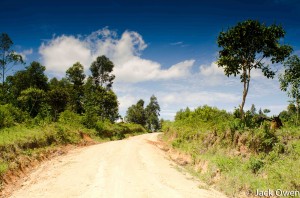 This is a land of maize and sugar cane, of small shambas (homesteads), red earth and mud walled huts. It is a part of Kenya that for me, personifies more than any other the ‘image of Africa’ that comes to mind whenever I am back home in Europe. It is a beautiful place.
This is a land of maize and sugar cane, of small shambas (homesteads), red earth and mud walled huts. It is a part of Kenya that for me, personifies more than any other the ‘image of Africa’ that comes to mind whenever I am back home in Europe. It is a beautiful place.
It wasn’t long before I had my first contact with the Life Straw program. Just on his way out of a house I came across Richard, one of the 4000 temporary staff distributing the filters. I stopped, we talked. In his opinion this was a great project, with a lot of potential. The distribution was hard work, but he was glad of the money. “And do people react well to the training?’ I asked. ” Mostly. The important thing is to give them the full hours training. I know that if they have an hour, they’ll understand how to use the Life Straw Family. The problem is with us, the workers. I always stay for the hour – if the family wants me to – but some of my colleagues try to work as fast as possible, it is a challenge”.
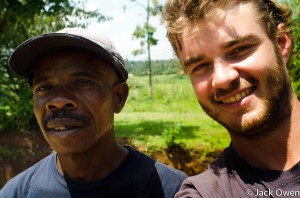 So, Richard shed a little light, just a little, on the reality of the implementation. How refreshing to get an honest perspective, away from the PR machine back in Kakamega. I took a photo, we shook hands, and off I went. Hmm, I wondered, what else might I stumble across on my ride through the green hills of Western?
So, Richard shed a little light, just a little, on the reality of the implementation. How refreshing to get an honest perspective, away from the PR machine back in Kakamega. I took a photo, we shook hands, and off I went. Hmm, I wondered, what else might I stumble across on my ride through the green hills of Western?
I had a policy – stop when you come across anyone, and talk to them. It was simple and effective. As anyone who has spent time in Kenya will tell you, people here like nothing more than a chat. So it wasn’t long before I came across Mr Ifedha, wheezing as he pushed his bike up the hill. “Hi! have you heard anything about this Life Straw thing?” I asked. “Hmm” came the reply. “Well I have heard of something, but it is not round here. Look, we use the river it is so close”. In a nutshell Mr Ifedha summed up the challenge. 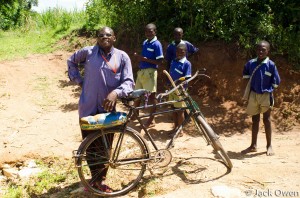
Changing ingrained behaviour relating to water and sanitation is a real challenge. It is not enough to say “Here you go, a filter”. Anyway, I thanked Mr Ifedha and moved on. With a $30m investment, these guys must know what they are doing, I mused, picking my way down a steep section of road running down to the river Mr Ifedha had pointed out. And of course they will be here for 10 years, so I guess they can iron out any issues they have along the way. And then there are the regional support centres that will look after repairs…. I’m glad I came out here to hear the local views (and see them!), but as ever nothing here is clear 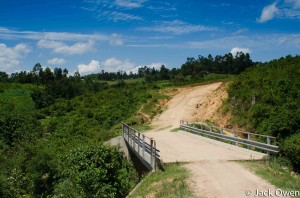 cut. And maybe there is a genuine role here for our partner Bridge Water Project. If we can build the LIfe Straw training materials into our own (much more thorough) community education program, then Bridge Water can really contribute to the success of this intervention. Maybe I’ll get one more opinion on the way home, I said to myself, as an old man hoved into view, herding his cattle to the river (anyone see the WASH issue here? Same river Mr Ifedha cited…answers on a postcard!).
cut. And maybe there is a genuine role here for our partner Bridge Water Project. If we can build the LIfe Straw training materials into our own (much more thorough) community education program, then Bridge Water can really contribute to the success of this intervention. Maybe I’ll get one more opinion on the way home, I said to myself, as an old man hoved into view, herding his cattle to the river (anyone see the WASH issue here? Same river Mr Ifedha cited…answers on a postcard!).
“Hello” I shouted, mindful of his age. He smiled a toothy smile, and we talked using a mixture of his poor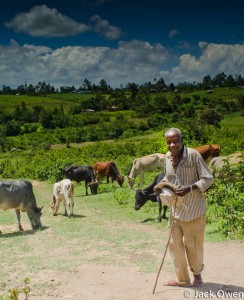 English and my horrendous Kiswahili. Over there, he pointed, “Our neighbours on the hill, they have them. But not us. Will they be coming here soon?” he asked. “I think so” I replied, “Ngoja tu”, “wait a little”. He smiled, and off he went, oblivious to the nature of the project happening in his homeland, and more concerned with watering his cattle at the river. Again, I thought, are they really rolling out this program with such little community engagement?
English and my horrendous Kiswahili. Over there, he pointed, “Our neighbours on the hill, they have them. But not us. Will they be coming here soon?” he asked. “I think so” I replied, “Ngoja tu”, “wait a little”. He smiled, and off he went, oblivious to the nature of the project happening in his homeland, and more concerned with watering his cattle at the river. Again, I thought, are they really rolling out this program with such little community engagement?
This project is ambitious in the extreme, and to an extent Vestergaard Frandsen should be congratulated. It will certainly 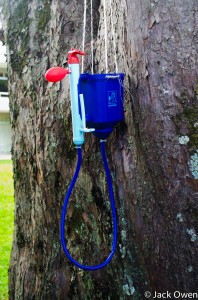 have a big impact on the lives of many people in Western Kenya. The danger though, is to think that because this is a ‘for profit’ initiative normal development rules need not apply. I’m talking about the crucial role of community participation, the need for dedicated and passionate project staff, the importance of ‘demand’ being expressed by the community itself, or the need to reach out to other stakeholders (such as us!). Development organisations have changed a lot over the years to try and incorporate some of these ideas and to become more accountable to the communities they serve. Perhaps, as the world starts to look at ‘humanitarian entrepreneurship’ as a potential development model, there should be an appreciation of the knowledge base the ‘traditional’ development community has to offer. I hope for all the world that this project works, partly because of the many people I personally know and love who will benefit. My gut feeling is that it will have challenges along the way, but then what kind of development work doesn’t?
have a big impact on the lives of many people in Western Kenya. The danger though, is to think that because this is a ‘for profit’ initiative normal development rules need not apply. I’m talking about the crucial role of community participation, the need for dedicated and passionate project staff, the importance of ‘demand’ being expressed by the community itself, or the need to reach out to other stakeholders (such as us!). Development organisations have changed a lot over the years to try and incorporate some of these ideas and to become more accountable to the communities they serve. Perhaps, as the world starts to look at ‘humanitarian entrepreneurship’ as a potential development model, there should be an appreciation of the knowledge base the ‘traditional’ development community has to offer. I hope for all the world that this project works, partly because of the many people I personally know and love who will benefit. My gut feeling is that it will have challenges along the way, but then what kind of development work doesn’t?
Collaboration is key. Between everyone. The good thing is that The Water Project, through our partners, is committed to communicating and sharing, and will endeavour to assist any organisation that is trying to contribute to the global water and sanitation challenge.
As for my ride through Western, I enjoyed it immensely, and although my research was anecdotal and brief, I feel I know a little more about the reality of this project than I did beforehand. I can’t wait to go back and see how they’re getting on!
Thanks for reading – any questions just use the comments section, or send me an email – [email protected]
Home More Like ThisTweet
